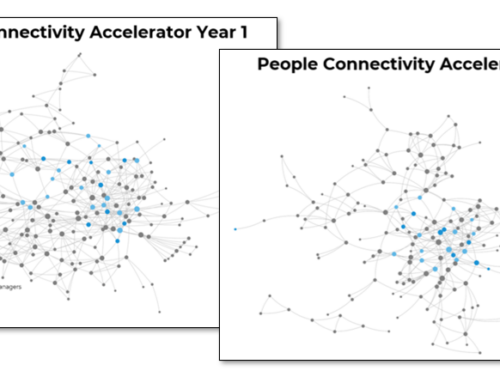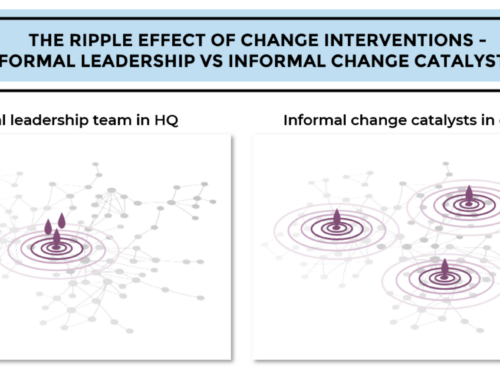BUILD CULTURE
Can You See Culture in a Network?
October 20th, 2023 | Build culture
Picture two different offices: In the first office, you hear the chatter of employees as they exchange morning greetings or pleasantries at the coffee machine. In the second, it’s silent, heads down, staring into their computer screens. What sets these two scenarios apart? The answer lies in the culture. Organizational culture is that abstract yet ever-present force that defines the experiences of those who work within an organization/company/team. But what does the world of organizational culture look like through a networked lens, the unseen dynamics at every workplace?

First, we must acknowledge that within any organization, culture isn’t a monolithic entity but rather the combination of microcultures or subcultures. These microcultures are present within informal networks, where energy flows, ideas are exchanged, and relationships are formed. They represent the diverse sets of values, norms, and behaviors that make up the mosaic of an organization. Whether it’s the IT department’s penchant for innovation or the finance team’s procedural strictness, these microcultures contribute to the overall organizational culture.
Zooming in further, we discover that the power of culture within networks often hinges on leaders or the magnetic, influential employees (see more on the #ThreePercentRule). In the context of a team, department, or organization, leaders, due to their formal roles, hold a lot of sway. Their actions and behaviors serve as role models that set the tone for their networks. A leader who champions openness and transparency will foster a culture of trust and collaboration, while one who micromanages may unwittingly cultivate a culture of suspicion and individualism. These displays of leadership can have profound ripple effects throughout the organization. In some extreme cases, we even see examples of bosses implementing intrusive computer monitoring measures akin to Big Brother, which raises unsettling questions about the type of culture they are promoting – one of surveillance and control rather than trust and empowerment??
Another area of organizational culture that is visible in networks is decision-making. We can see in the networks of those organizations with strong hierarchical cultures that decision-making is often concentrated in the hands of a select few senior leaders, creating a culture that constricts the flow of information and stifles innovation. This top-down approach can lead to a sense of frustration or disempowerment among employees. In contrast, leaders who embrace more decentralized decision-making empower employees to take ownership of their work, instead of always going through the leaders, fostering a culture of teamwork and agility.
Yet, in the remote and hybrid age of work, the question of what culture looks like becomes even more complex! The divide between those who thrive in remote environments and those who crave the human connection of the office is evident. There is a clash of individuals’ desire to pick the work environment. How do we rectify the loneliness experienced by some remote workers (Innovisor has found since the rise of remote work/pandemic that those left out of informal networks have risen to 30%), with the flexibility and autonomy that comes with having a decision over one’s own schedule/place of work.
In conclusion, my answer to whether we can see culture in a network is a resounding yes! Every facet of our daily work interactions, from casual banter to the structure of meetings and communication patterns, is filled with traces of culture. Leaders shape the tone and direction of their networks, while decision-making processes reflect the broader cultural dynamics at play. As we navigate the ever-evolving landscape of work, understanding the power of these insights within organizational networks is vital to foster a positive workplace.
BUILD CULTURE
Can You See Culture in a Network?
October 20th, 2023 | Build culture
Picture two different offices: In the first office, you hear the chatter of employees as they exchange morning greetings or pleasantries at the coffee machine. In the second, it’s silent, heads down, staring into their computer screens. What sets these two scenarios apart? The answer lies in the culture. Organizational culture is that abstract yet ever-present force that defines the experiences of those who work within an organization/company/team. But what does the world of organizational culture look like through a networked lens, the unseen dynamics at every workplace?

First, we must acknowledge that within any organization, culture isn’t a monolithic entity but rather the combination of microcultures or subcultures. These microcultures are present within informal networks, where energy flows, ideas are exchanged, and relationships are formed. They represent the diverse sets of values, norms, and behaviors that make up the mosaic of an organization. Whether it’s the IT department’s penchant for innovation or the finance team’s procedural strictness, these microcultures contribute to the overall organizational culture.
Zooming in further, we discover that the power of culture within networks often hinges on leaders or the magnetic, influential employees (see more on the #ThreePercentRule). In the context of a team, department, or organization, leaders, due to their formal roles, hold a lot of sway. Their actions and behaviors serve as role models that set the tone for their networks. A leader who champions openness and transparency will foster a culture of trust and collaboration, while one who micromanages may unwittingly cultivate a culture of suspicion and individualism. These displays of leadership can have profound ripple effects throughout the organization. In some extreme cases, we even see examples of bosses implementing intrusive computer monitoring measures akin to Big Brother, which raises unsettling questions about the type of culture they are promoting – one of surveillance and control rather than trust and empowerment??
Another area of organizational culture that is visible in networks is decision-making. We can see in the networks of those organizations with strong hierarchical cultures that decision-making is often concentrated in the hands of a select few senior leaders, creating a culture that constricts the flow of information and stifles innovation. This top-down approach can lead to a sense of frustration or disempowerment among employees. In contrast, leaders who embrace more decentralized decision-making empower employees to take ownership of their work, instead of always going through the leaders, fostering a culture of teamwork and agility.
Yet, in the remote and hybrid age of work, the question of what culture looks like becomes even more complex! The divide between those who thrive in remote environments and those who crave the human connection of the office is evident. There is a clash of individuals’ desire to pick the work environment. How do we rectify the loneliness experienced by some remote workers (Innovisor has found since the rise of remote work/pandemic that those left out of informal networks have risen to 30%), with the flexibility and autonomy that comes with having a decision over one’s own schedule/place of work.
In conclusion, my answer to whether we can see culture in a network is a resounding yes! Every facet of our daily work interactions, from casual banter to the structure of meetings and communication patterns, is filled with traces of culture. Leaders shape the tone and direction of their networks, while decision-making processes reflect the broader cultural dynamics at play. As we navigate the ever-evolving landscape of work, understanding the power of these insights within organizational networks is vital to foster a positive workplace.
Related articles
Share article
Share article
Conversations with business practitioners who got it done!
Access proven strategies from industry leaders across various sectors and company sizes.
Fix Your Culture! This is How, written by Innovisor’s CEO Jeppe Hansgaard and Culture Expert Hilton Barbour, delivers exclusive interviews with global professionals who have successfully implemented culture change using Change Analytics and Organizational Network Analysis.










